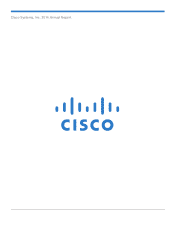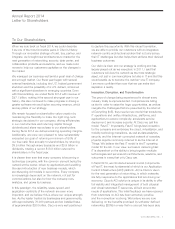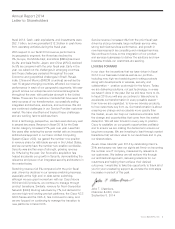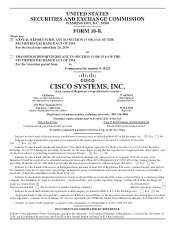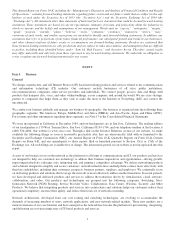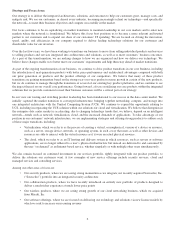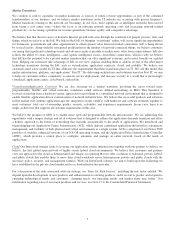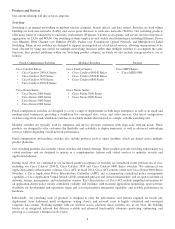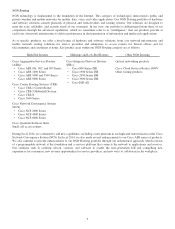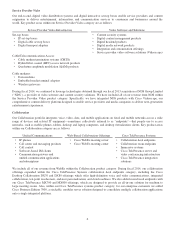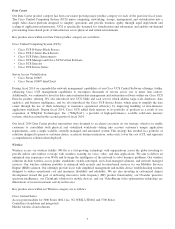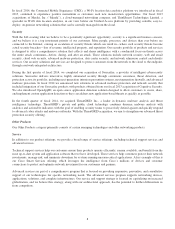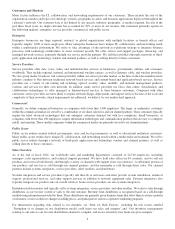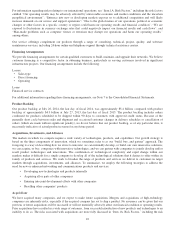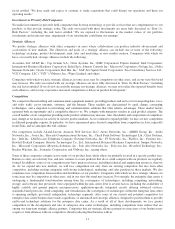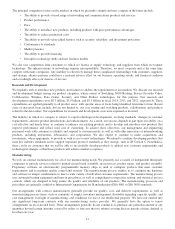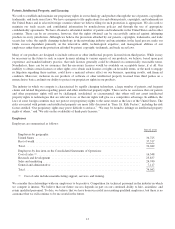Cisco 2014 Annual Report Download - page 11
Download and view the complete annual report
Please find page 11 of the 2014 Cisco annual report below. You can navigate through the pages in the report by either clicking on the pages listed below, or by using the keyword search tool below to find specific information within the annual report.
Market Transitions
We continue to seek to capitalize on market transitions as sources of future revenue opportunities as part of the continued
transformation of our business, and we believe market transitions in the IT industry are occurring with greater frequency.
Market transitions relating to the network are becoming, in our view, more significant as intelligent networks have moved
from being a cost center issue—where the focus is on reducing network operating costs and increasing network-related
productivity—to becoming a platform for revenue generation, business agility, and competitive advantage.
We believe that that the next wave of dramatic Internet growth will come through the confluence of people, process, data, and
things, which we refer to as the IoE. We believe that IoE, by bringing “everything” online, will create significant opportunities
for businesses, governments and other organizations to obtain greater value from networked connections. IoE is being driven
by several factors. Along with the anticipated proliferation in the number of network-connected things, we believe customers
are seeing that significant technology trends and advances make it possible to realize more value from connectedness. IoE also
reflects the ability to create intelligence—and capture intelligence faster—from these connections, which is why we believe
that IoE has the potential to be a pivotal market transition that can offer significant economic and societal benefits on a global
basis. Helping our customers take advantage of IoE, in our view, requires enabling them to address several of the other major
technology transitions driving the IoE, such as virtualization, application centricity, cloud, and mobility. We believe our
customers need a new model for IT that addresses the requirements that these transitions place on IT. We call this model that
unifies infrastructure, platform, and applications “Fast IT.” By delivering architectures and solutions based on Fast IT, we aim
to help our customers reduce complexity, accelerate service deployment, and increase security in a world that is increasingly
virtualized, application centric, cloud-based, and mobile.
Virtualization/Application Centricity We are also focusing on a market transition involving the move toward more
programmable, flexible, and virtual networks, sometimes called software defined networking, or SDN. This transition is
focused on moving from a hardware-centric approach for networking to a virtualized network environment that is designed to
enable flexible, application-driven customization of network infrastructures. We believe the successful products and solutions
in this market will combine application-specific integrated circuits (ASICs) with hardware and software elements together to
meet customers’ total cost of ownership, quality, security, scalability, and experience requirements. In our view, there is no
single architecture that supports all customer requirements in this area.
We believe the promise of SDN is to enable more open and programmable network infrastructure. We are addressing this
opportunity with a unique strategy and set of solutions that is designed to address the application demands transition and offers
a holistic approach to the future of networking that responds automatically to the needs of applications. We introduced and
began shipping our Application Centric Infrastructure (ACI), which delivers centralized application-driven policy automation,
management, and visibility of both physical and virtual environments as a single system. ACI is comprised of our Nexus 9000
portfolio of switches, enhanced versions of our NX-OS operating system, and the Application Policy Infrastructure Controller
(APIC), which provides a central place to configure, automate, and manage an entire network, based on the needs of
applications.
Cloud Our Intercloud strategy seeks to leverage our application centric infrastructure together with our partners to deliver, we
believe, the first global open network of highly secure hybrid cloud environments. We believe that customers and partners
view our approach to the cloud as differentiated and unique, recognizing that we offer a solution to federated, private, hybrid,
and public clouds that enables them to move their cloud workloads across heterogeneous private and public clouds with the
necessary policy, security, and management features. With our InterCloud solution, we aim to build upon the leadership we
have established in the private cloud market and as a cloud infrastructure provider.
For a discussion of the risks associated with our strategy, see “Item 1A. Risk Factors,” including the risk factor entitled “We
depend upon the development of new products and enhancements to existing products, and if we fail to predict and respond to
emerging technological trends and customers’ changing needs, our operating results and market share may suffer.” For
information regarding sales of our major products and services, see Note 17 to the Consolidated Financial Statements.
3

